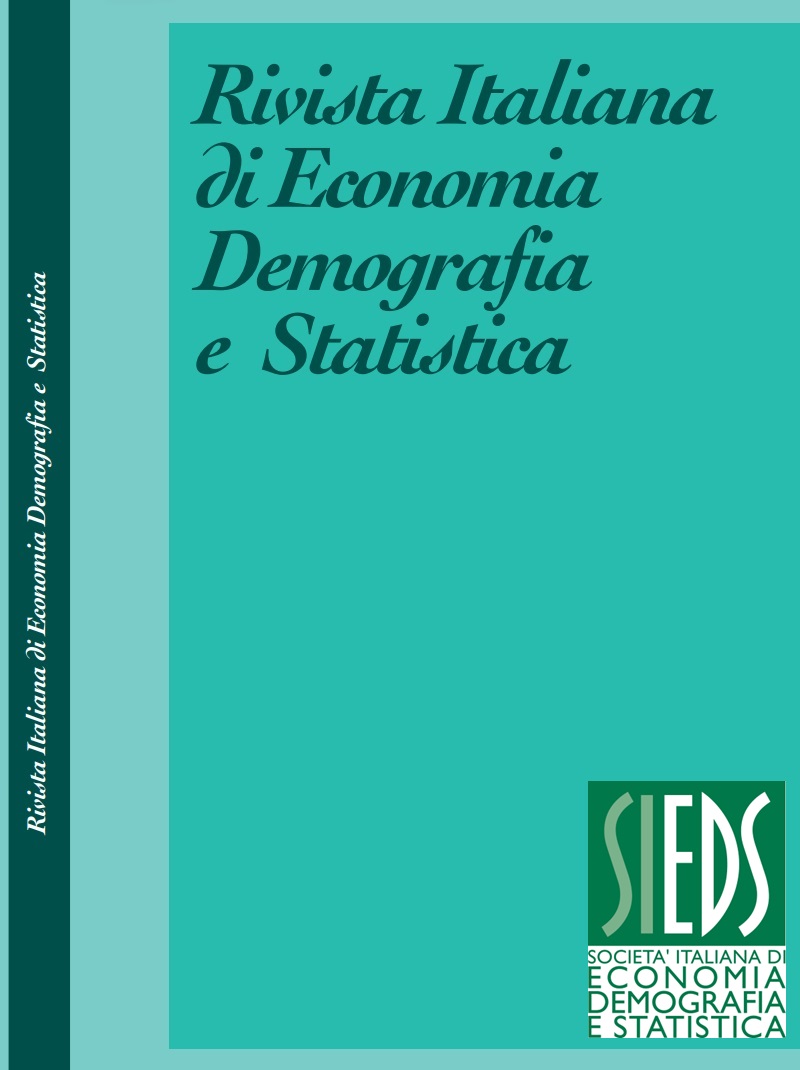Equivalence scales for the distribution of consumption expenditures in Italy: proposed methods to update the Carbonaro Scale
DOI:
https://doi.org/10.71014/sieds.v79i2.330Abstract
Comparing the well-being of different households requires knowledge not only of the resources available to them, but also of their needs. This seems to be possible, albeit with some effort and approximation, by defining an equivalence coefficient that indicates, using a reference household, how much a family with different characteristics needs to enjoy the same standard of living. Equivalence scales are typically used to make the expenditure of households of different size and composition comparable. In this paper, using data from the 2017-2019 Italian Household Budget Survey (IHBS), we propose an equivalence scale calculated using a simple method based on recent improvements in absolute poverty methodology. To validate our analysis, we compared the results with the original Carbonaro scale calculated in 1985, a version of the Carbonaro scale updated using the 2017-2019 HBS data, and scales calculated using complete household demand systems. Finally, we present a simple and intuitive method to assess which of these scales performs better in the Italian economic context. Preliminary results suggest that the Carbonaro scale, as originally constructed, is now outdated and needs to be revised. On the contrary, the proposed approach of using absolute poverty thresholds as a proxy for essential expenditure seems to provide encouraging results, especially in the light of the evolution of the Italian socio-economic context and the relationship that must exist between absolute and relative poverty.
References
BANKS J., BLUNDELL R., LEWBEL, A. 1997. Quadratic Engel curves and consumer demand. Rev Econ Stat, Vol, 79, No, 4, pp. 527–39. DOI: https://doi.org/10.1162/003465397557015
BLUNDELL R., LEWBEL A., 1991. The information content of equivalence scales. J Econ, Vol. 50, pp. 49–68. DOI: https://doi.org/10.1016/0304-4076(91)90089-V
BUHMANN B., RAINWATER L., SCHMAUS G., SMEEDING T., 1988. Equivalence Scales, Well-Being, Inequality and Poverty: Sensitivity Estimates Across Ten Countries Using the Luxembourg Income Study (LIS) Database, Review of Income and Wealth, Vol. 94, pp.115-42. DOI: https://doi.org/10.1111/j.1475-4991.1988.tb00564.x
CARBONARO, G. 1985. Nota sulle scale di equivalenza, in Commissione di indagine sulla povertà e sull’emarginazione, La povertà in Italia, Roma, Istituto Poligrafico e Zecca dello Stato.
CARBONARO G., 1991. La distribuzione quantitativa del reddito, in MARBACH G. (Ed.) Statistica economica, Torino, UTET, pp. 205-228.
CUTILLO A., RAITANO, M., SICILIANI, I., 2022. Income-Based and Consumption-Based Measurement of Absolute Poverty: Insights from Italy. Social Indicators Research, Vol. 161, pp. 689–710. DOI: https://doi.org/10.1007/s11205-020-02386-9
DARVAS Z. 2017. Why is it so hard to reach the EU’s poverty target? Policy Contribution Issue No. 1, Bruegel, Brussels.
DEATON A., 1975. Models and projections of demand in Post-War Britain. Cambridge Studies in Applied Econometrics. Springer, Cambridge. DOI: https://doi.org/10.1007/978-1-4899-3113-9
DEATON A., MUELLBAUER J., 1980. An almost ideal demand system. American Economic Review Vol.70, No.3:7, pp. 312-326.
DEATON A., MUELLBAUER J., 1986. On measuring child costs: with applications to poor countries. Journal of Political Economy Vol. 94, No. 4:7, pp. 20–744. DOI: https://doi.org/10.1086/261405
Deaton A., Zaidi S., 2002. Guidelines for Constructing Consumption Aggregates for Welfare Analysis, World Bank Working Paper, No. 135.
DE SANTIS G., 1996. La misura della povertà in Italia. Scale di equivalenza e aspetti demografici, Roma, Istituto Poligrafico e Zecca dello Stato.
DUDEL C., GARBUSZUS J.M., SCHMIED J., 2021. Assessing differences in household needs: a comparison of approaches for the estimation of equivalence scales using German expenditure data. Empirical Economics. Vol. 60: pp. 1629-59. DOI: https://doi.org/10.1007/s00181-020-01822-6
ENGEL E., 1895. Die Productions- und Consumtionsverhältnisse des Königreichs Sachsen. In: ANLAGE I., HEINRICH C. (Eds) Die Lebenskosten Belgischer Arbeiter-Familien früher und jetzt, Dresden.
FERREIRA F., RAVALLION M. 2011. Poverty and Inequality: The Global Context. In NOLAN, B., W. SLAVERDA, AND T. M. SMEEDING (eds.) Oxford Handbook of Economic Inequality. Oxford: Oxford University Press. DOI: https://doi.org/10.1093/oxfordhb/9780199606061.013.0024
HOWE H., POLLAK R.A., WALES T.J. 1979 Theory and time series estimation of the quadratic expenditure system. Econometrica, Vol 47, No. 5, pp.1231–47. DOI: https://doi.org/10.2307/1911960
ISTITUTO NAZIONALE DI STATISTICA, 2009. La misura della povertà assoluta. Metodi e norme, No. 39. Roma.
RAY, R. 1983. Measuring the costs of children: an alternative approach. Journal of Public Economics, Vol 22, No 1, pp.89–102. DOI: https://doi.org/10.1016/0047-2727(83)90058-0
STONE, R. 1954. Linear expenditure systems and demand analysis: an application to the pattern of British demand. Economic Journal, Vol. 64, No. 255, pp, 511–527. DOI: https://doi.org/10.2307/2227743
Downloads
Published
Issue
Section
License
Copyright (c) 2025 Andrea Cutillo, Alessandro Romeo, Livia Celardo

This work is licensed under a Creative Commons Attribution 4.0 International License.



